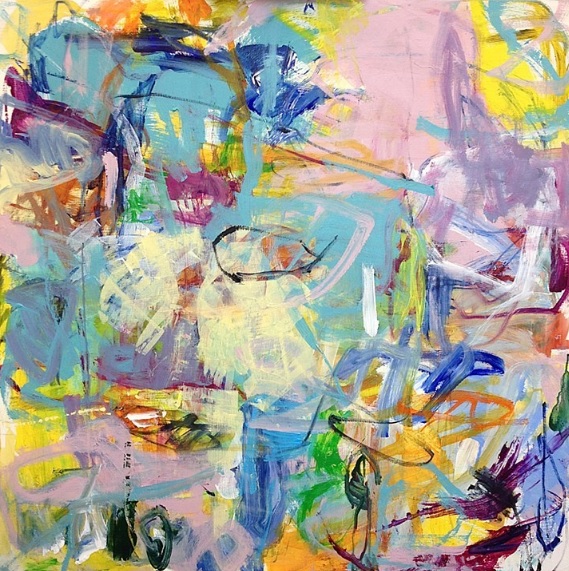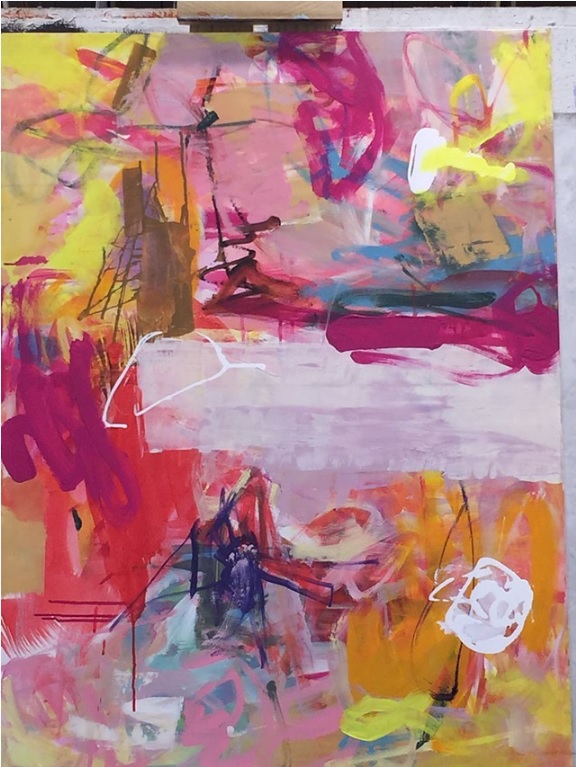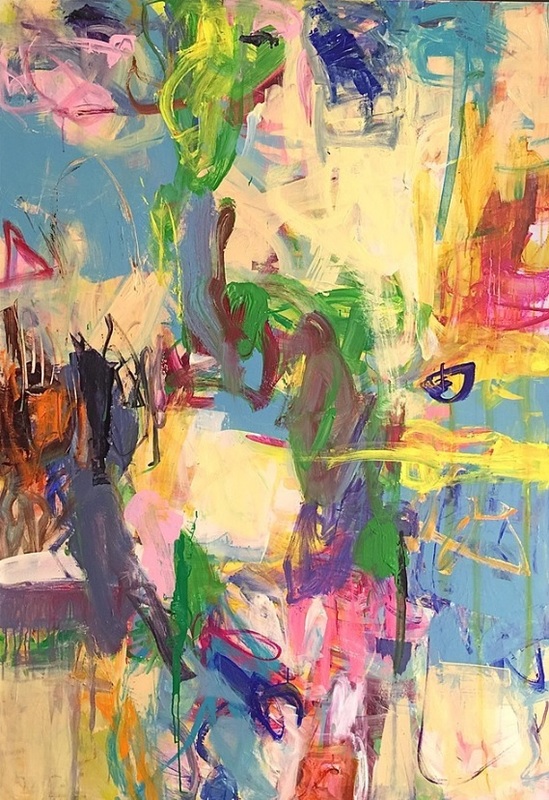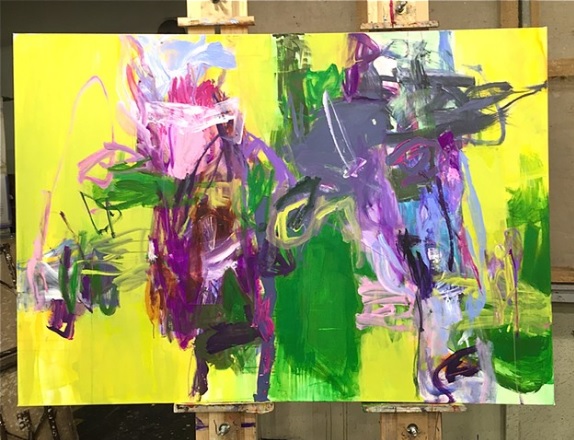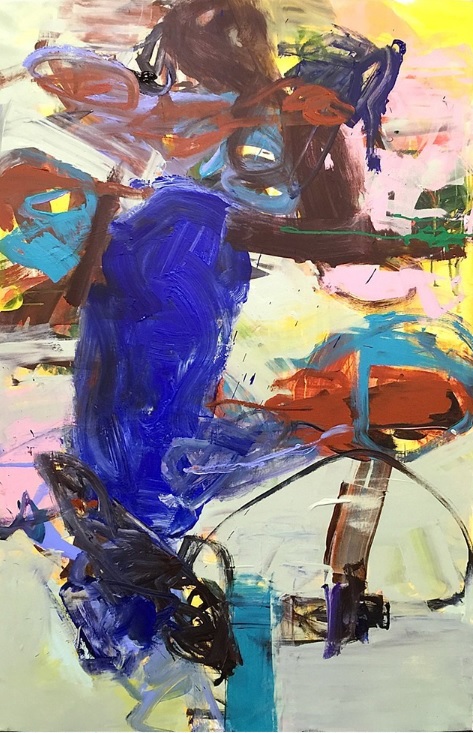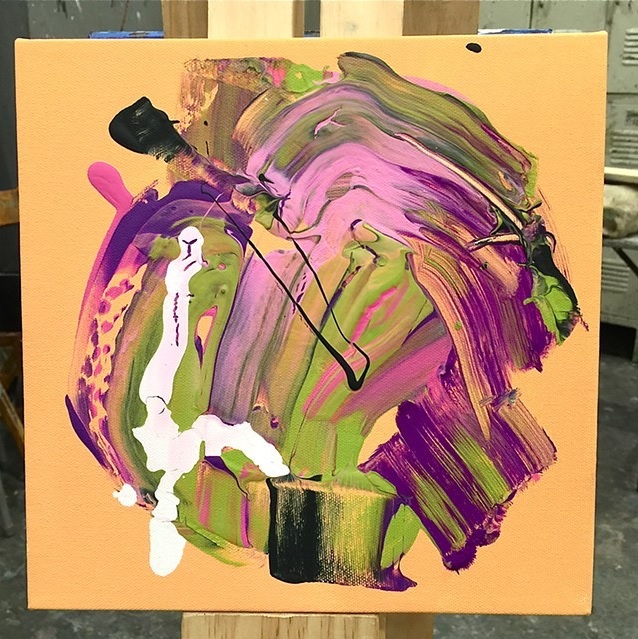Ryoko Endo
Artist’s Statement
Color is the essence of my art. Even though people often mistake my works for oil paintings, they are actually in acrylic. I use water to manipulate the degree of opaqueness or transparency of the medium. I want to pursue the possibilities of color—harmonious and discordant.
I am inspired by the colorful fruits and vegetables at the farmers markets and by the vibrant flowers—in Japan, flowers and trees are believed to possess the essence of God. Movement is also important—the way I move an element empowers my pictures. Shapes dissolve and become meaningless. Brushstrokes vary according to speed, thickness, density, and rhythm.
Calligraphy requires complete concentration, as it is an unforgiving practice. There are no second chances. In this respect it becomes a type of meditation. Like most Japanese children, I learned traditional Sumi ink calligraphy at school, but it was the dynamic, creative style of Master Shingai Tanaka, which blended classical and contemporary calligraphy, that truly inspired me. I met him at an exhibition of his work at the French Embassy in New York in 2002, and we continued to stay in touch until his death in 2007.
The year before, I went to Lyons, France, to study with him. I am also attracted to the human form—the faces of the farmers at the markets are so real, so earthbound, that they captivate me. I do not focus on anatomy but rather seek to capture the emotions that each model reveals without words. All the models are possessed of an inner beauty, whether they are skinny, flabby, elderly, or plain. I intuit each model’s message from his or her appearance, expression, wrinkles, and assimilate that into my work. Every time I am in front of a new canvas, I want to make something different. I do not want to stay in my comfort zone. I work to break away, again and again. The process is never static. When I hit a wall and am struggling, I remember the words of my mentor Kikuo Saito, “Trust the color. More color. Color is power.”
Untitled-3
Acrylic on canvas
40 x 60 inch
2015
Biography
I was born into a traditional family in Fukushima, Japan, in 1951. My mother made me wear a glove on my dominant left hand so that I would learn to use my right—lefthanded children brought shame on a family. To this day, I can paint with both hands. The study of pure art was looked down upon, so I majored in graphic design and typography at Musashino Art University in Tokyo. I became the editor and art director for a food magazine, where I worked for twenty-two years. In 1994, by which time both of my parents had passed away,
I was free to follow my dreams. I bought a one-way ticket to New York. I worked in the restaurant business, becoming the manager for, among other places, the last Japanese restaurant at the World Trade Center. After many years, however, I realized that I was not fulfilled and again found myself questioning my future. This time I was fifty-four, in the autumn of my life; I was determined to discover what would gratify and feed my soul before the winter season began. One day in September 2006 I came upon the Art Students League. I entered the building, and the smell of oil paint immediately brought me back to happier days as a student. The gallery had an instructors show with abstract painting. \
There were brilliant vivid colors. Instructor Kikuo Saito's brilliant vivid splashes of colors were so refreshing and so moving to me that it drove away my sadness. I was bursting from within and felt like I wanted to paint as he did. It was Kikuo’s one painting that motivated me to begin painting abstract. I had not picked up a brush in more than thirty-two years when I began studying under Kikuo Saito. Six months later, my pictures were receiving honors in our class shows. Had it not been for my earlier misfortunes, I might never have realized my potential as an artist. In all my paintings I try to express a sense of gratitude, as painting saved me. I hope my work encourages others to find their true path in life.
I was born into a traditional family in Fukushima, Japan, in 1951. My mother made me wear a glove on my dominant left hand so that I would learn to use my right—lefthanded children brought shame on a family. To this day, I can paint with both hands. The study of pure art was looked down upon, so I majored in graphic design and typography at Musashino Art University in Tokyo. I became the editor and art director for a food magazine, where I worked for twenty-two years. In 1994, by which time both of my parents had passed away,
I was free to follow my dreams. I bought a one-way ticket to New York. I worked in the restaurant business, becoming the manager for, among other places, the last Japanese restaurant at the World Trade Center. After many years, however, I realized that I was not fulfilled and again found myself questioning my future. This time I was fifty-four, in the autumn of my life; I was determined to discover what would gratify and feed my soul before the winter season began. One day in September 2006 I came upon the Art Students League. I entered the building, and the smell of oil paint immediately brought me back to happier days as a student. The gallery had an instructors show with abstract painting. \
There were brilliant vivid colors. Instructor Kikuo Saito's brilliant vivid splashes of colors were so refreshing and so moving to me that it drove away my sadness. I was bursting from within and felt like I wanted to paint as he did. It was Kikuo’s one painting that motivated me to begin painting abstract. I had not picked up a brush in more than thirty-two years when I began studying under Kikuo Saito. Six months later, my pictures were receiving honors in our class shows. Had it not been for my earlier misfortunes, I might never have realized my potential as an artist. In all my paintings I try to express a sense of gratitude, as painting saved me. I hope my work encourages others to find their true path in life.











